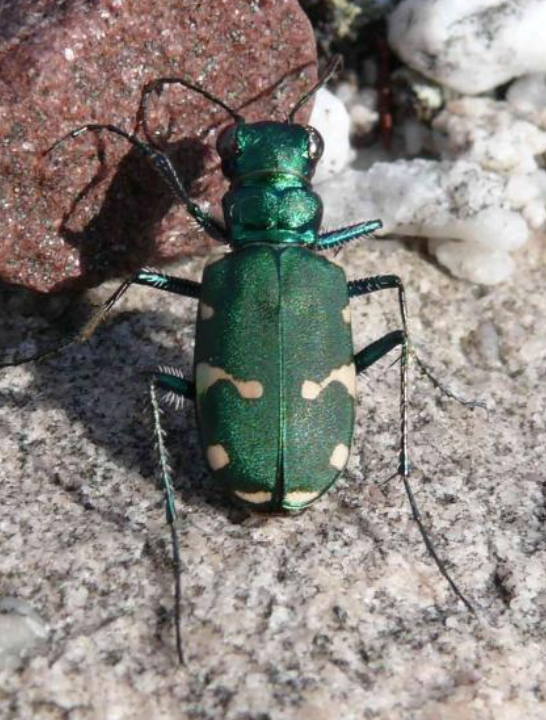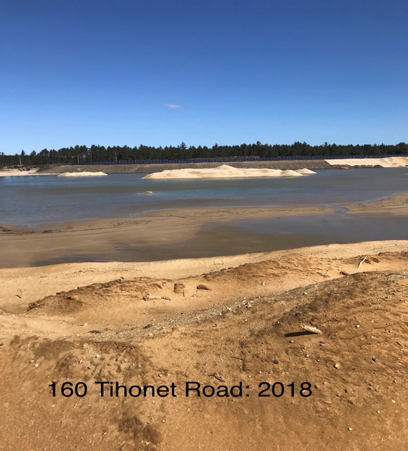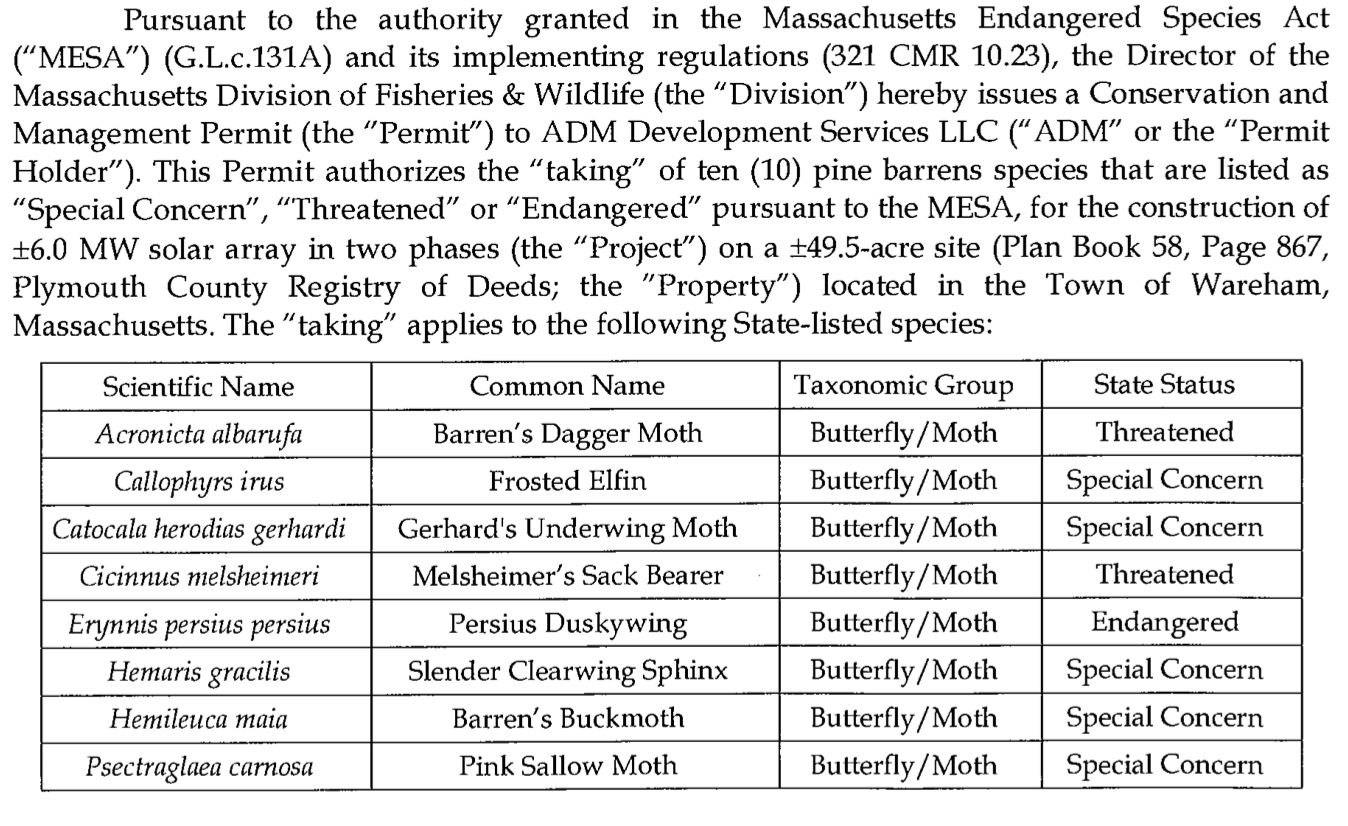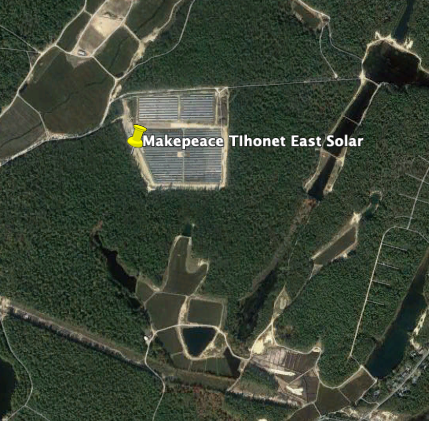The state Natural Heritage & Endangered Species Program (NHESP) gave Makepeace a “take permit” for 10 rare and endangered species at the site
Did engineers Beals+Thomas misrepresent the sand and gravel mining at this site as cranberry agriculture?
Land clearing and mining started in about 2014 and covered 50 acres
The Wareham Selectboard looked the other way and never required an earth removal permit
Endangered Persuis Duskywing Butterfly, Northern Barrens Tiger Beetle may have been extirpated by Makepeace


From 2014 to 2021, AD Makepeace clearcut and strip mined 50 acres of pristine Pine Barrens habitat classified as Priority Habitat by NHESP under the Massachusetts Endangered Species Act. Makepeace leased the land to Borrego Solar to build 50- acre solar porject. Now it is owed by another solar company, Clearway.
Chronology and Background
In 2014, ADM applied to the Wareham Planning Board for site plan review to install Phase 1 of a 52 acre ground mounted solar project to be built by Borrego Solar. Jim Kane wrote to the Planning Board Chair George Barrett this was likely Makepeace’s “last large ground mounted solar project under the existing regulatory system”. A few years later, the company revealed plans to build at least three more large grounded solar projects in Wareham: at 140 and 150 Tihonet Road and 27 Charge Pond Road. Makepeace built about 15 large ground mounted solar projects in Wareham and Carver. Most of these involved sand and gravel mining. Makepeace’s solar projects, most of them preceded by mining, include:
71 Charlotte Furnace Road, Wareham
Farm to Market Road, Wareham
Cranebrook Solar, Cranberry Road, Carver
0 Hammond Street, Carver
Golden Field Solar (59 Fedreal Road) Carver
276 Federal Road, Carver
Swan Holt Bogs (0 Pond Street) Carver
As of 2023, Makepeace has publicly announced plans for these solar projects:
Wareham: 140 Tihonet Road, 150 Tihonet Road and 27 Charge Pond Road, Jordan Road
Carver: Wankinko Bog area, according to ISO New England
Plymouth: Canning Bogs on Frogfoot Brook and Jordan Road.
At the 160 Tihonet Road, Wareham site, in 2014, Makepeace told the state environmental review office, Massachusetts Environmental Policy Act (MEPA) “The site will be cleared and graded to a level area ranging from approximately 64’ to 68’ above sea level”. MEPA ignored the environmental impacts of changing the topography and removing groundwater protection. It blindly repeated this in its MEPA Certificate. Makepeace’s consultant Beals + Thomas said in the MEPA Environmental Notification Form: it is “anticipated that excavated earth material will be used in the vicinity of the site such that travel via town roads will be avoided.” Where did this actually go? How much was removed?
Did Makepeace truck the sand and gravel across the Wankinko River into Carver to its Read Custom Soils for commercial sale or sell it directly to haulers? Makepeace uses back roads through its cranberry lands to transport sand from mining sites to Read, as implied by Beals + Thomas in the .
Between 2014 and 2018, approximately 22 acres of the 52 acre site were cleared and the first phase of the Borrego solar project installed in approximately 2015.
Endangered Species Impacts and NHESP “Take Permit”

The 160 Tihonet Road location was once “Priority Mapped Habitat” designated under the Massachusetts Endangered Species Act. In 2015, Mass Wildlife, which is supposed to protect our wildlife and rare natural plant and animal communities gave Makepeace a permit to kill 10 Pine Barrens species protected by law under the Massachusetts Endangered Species Act (MESA). This included the endangered Northern Barrens Tiger Beetle and Persius Duskywing butterfly.
The MassWildlife issued the permit through its Natural Heritage and Endangered Species Program (NHESP). The permit to kill, or “take” the species is ironically called a “Conservation and Management Permit”. There is supposed to be “mitigation” when this happens but how can a species be conserved and “managed” when large swarths of its habitat is destroyed? What is the cumulative impact of all the deforestation by Makepeace and other solar and sand mining operations in the Pine Barrens?
Here is an excerpt from the 2015 NHESP permit for Makepeace to “take” 10 legally protected species so it could say it was strip mining 50 acres “in compliance with the state endangered species law.”



Makepeace’s Letter to the Planning Board, 2014
In a letter to the Wareham Planning Board in 2014, Jim Kane, Makepeace CEO said “This project is the same cookie cutter solar project like Charlotte Furnace and Tihonet West solar in Wareham and Federal Road in Carver.” At these three other sites, solar was preceded by forest clear-cuts, endangered species habitat destruction and extraction and commercial sale of sand and gravel. Does “cookie cutter” mean environmental destruction and killing off endangered and rare species to Makepeace CEO Jim Kane?

This is a total coverup by Makepeace and town officials!
All for the almighty dollar they are endangering every living thing in this area (including people). I moved here thinking that this was a wonderful spot for being in nature. I think I was better off in the city!! I am appalled and mad!!